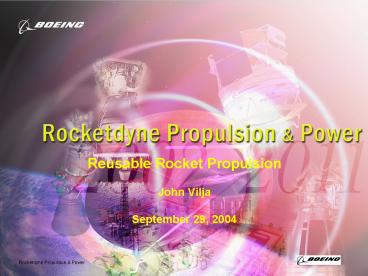Reusable Rocket Propulsion - PowerPoint PPT Presentation
1 / 10
Title:
Reusable Rocket Propulsion
Description:
Rocketdyne Propulsion & Power. Reusable Rocket Propulsion. John Vilja. September 29, 2004 ... Full power achieved in 6 tests. Dual Engine 3 tests as planned ... – PowerPoint PPT presentation
Number of Views:2444
Avg rating:3.0/5.0
Title: Reusable Rocket Propulsion
1
- Reusable Rocket Propulsion
- John Vilja
- September 29, 2004
2
Reusable Launch Vehicle Evolution
Space Shuttle 1980s to Present
Two Stage to Orbit 2000s
Single Stage to Orbit 1990s
3
Reliability, Maintainability Supportability
Vehicle Figure of Merit
Engine Figure of Merit
Failure Modes
Reliability
Crit 1
Loss of Vehicle, Loss of Crew
Cat. Failures
Planned Maintenance
Benign Engine Shutdown
Loss of Mission
Crit 1R or 2
Availability Cost/Eng/Flt
Unplanned RR/ Maintainability
Crit 3
Unplanned Maintenance
Maintainability Supportability
Logistics Support Plan
4
Analysis Process Improvement
- Hydrodynamic CFD Analysis
3-D Model
Historical Tools Design Process
6 Months/ Iteration
Analysis Model Generation
Pressure Boundary Condition
Analysis
Mesh
Integrated Product Development Process Tools
lt1 Week/ Iteration
Structural Analysis
Time
9705091c.ppt aw
5
Cycle Time to 100 Power Level Reduced
SSME
J2
J2
RS-68
RS-68
SSME
6
Test Success Comparison
200 150 100 50 0
SSME 1st Flight
Major Failures (SSME) Causing Redesign/Retest
615 Tests
Engine Test Failures
RS-68
183 Tests
No Major Failures
500
1000
1500
2000
2500
Days From 1st Engine Test
RS68-871-35 Druyun/Weiss
7
X-33 Aerospike Testing Highly Successful
- Single thruster - 13 tests, 985 seconds
- Multi-Cell - 10 tests, 49 seconds
- Powerpack - 17 tests, 1506 seconds
- Single Engine - 14 tests, 1513 seconds
- Full power achieved in 6 tests
- Dual Engine 3 tests as planned
- Less than 4 years development required
Unprecedented success achieved with extensive
test program
8
IPD Engine Provides Reusable Technology
9
SLI/NGLT Engine Comparison w/SSME
RS-83 FRSC
RS-84 ORSC
RS-85 Expander
SSME
390 klb, sl
640 klb, sl
1,050 klb, sl
350 klb, vac
10
Summary
- RLV engine requirements continue to evolve
- Space Shuttle provides anchor data for cost
reliability - Improved engineering tools reduce development
cost and improve engine quality - Component technology programs providing results
- NASA NGLT effort ended this year slowing progress
- AFRL/NASA IPD program entering test early 2005
- New propulsion could be available to support 2nd
generation RLV by 2010































